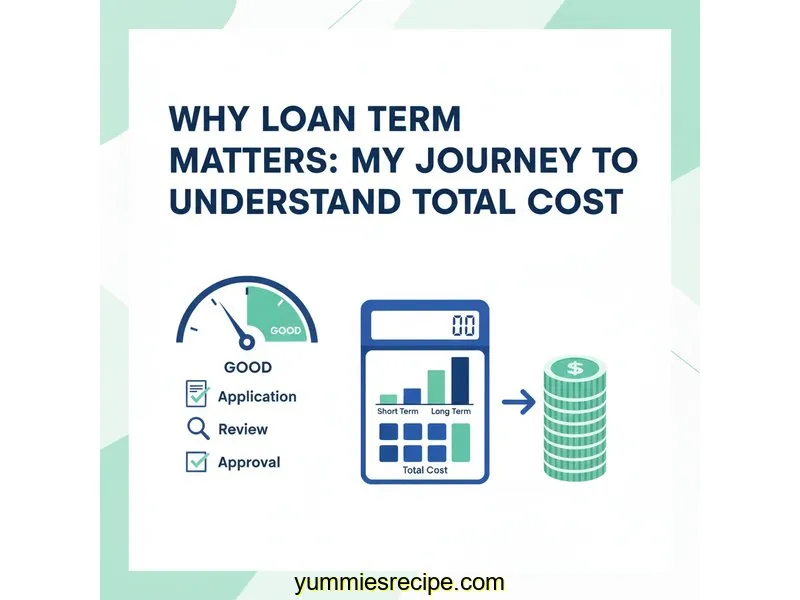
Auto Loan Calculator
Calculate payments over the life of your Loan
Home Blog Privacy Terms About Contact
Calculate payments over the life of your Loan
Home Blog Privacy Terms About ContactPublished on October 13, 2025

For the longest time, my understanding of loans was deceptively simple: find the lowest monthly payment you can afford. It seemed like the most logical approach to managing my cash flow. My personal finance journey, however, often starts with a simple question that unravels a much bigger topic. This time, the question was sparked by a hypothetical project I was planning—a small workshop setup in my garage that I estimated would cost around $11,750.
As I started plugging numbers into online loan calculators, I naturally gravitated toward the options that offered the lowest monthly bill. A five-year term looked so much more manageable than a four-year term. The monthly number was smaller, and in my mind, that meant it was "cheaper." But a nagging feeling told me I was missing something important. How could paying for a longer period of time possibly be cheaper? Was the math really that straightforward?
My goal wasn't to make a financial decision, but to satisfy my own curiosity. I wanted to peel back the layers and understand the mechanics behind the numbers. My initial attempts were clumsy; I'd enter the loan amount, the interest rate, and then toggle the loan term back and forth between 48 months and 60 months. I’d watch the "Monthly Payment" number go up and down, confirming my basic assumption. But other numbers on the screen—like "Total Interest Paid"—seemed like secondary details. I didn't yet realize they were telling the most important part of the story.
This journey became a personal mission to understand the relationship between time, interest, and money. It was about moving from a one-dimensional view (the monthly payment) to a three-dimensional understanding of how a loan actually works over its entire life. This is about understanding how calculations work, not financial advice. It’s the story of how I taught myself to read the whole story a calculator tells, not just the first chapter.
My confusion began with a very specific comparison. Using an online calculator, I set up two scenarios for my hypothetical $11,750 project. I found a representative interest rate of 6.3% to use for my educational exercise. The only thing I changed between the two calculations was the loan term.
Here’s what my screen showed me:
The calculator immediately produced the monthly payments. For the 48-month term, the payment was calculated at around $276.10. For the 60-month term, it was $226.96. My eyes immediately locked onto the difference: about $49 a month. My initial, gut reaction was that Scenario B was the "better" deal. Saving nearly $50 every month felt significant. It seemed obvious, almost too obvious.
This is where my mistake in thinking occurred. I was focusing exclusively on the short-term cash flow impact. My brain was stuck on the idea that having an extra $49 in my pocket each month was the most important variable. I wasn't thinking about the bigger picture—the total number of payments I would be making. I knew, intellectually, that the 60-month term meant 12 extra payments, but I hadn't done the simple math to see what that actually meant in dollars and cents.
My frustration grew because I felt like I was being tricked by the numbers, or rather, by my own interpretation of them. The math had to be right, but my understanding was clearly flawed. I printed out the results from the calculator, including the full amortization schedules (those giant tables of numbers I usually ignored), and laid them side-by-side. I stared at the two monthly payments, trying to grasp why the lower one felt like a trap. It was the moment I realized that to truly understand the cost, I couldn't just look at one number in isolation. I needed to learn how all the numbers—principal, interest, term, and total payments—were connected.
The breakthrough didn't come from a complex formula, but from a single, overlooked field on the loan calculator. After staring at the two scenarios, I forced myself to ignore the monthly payment number and scan the rest of the results. My eyes landed on a field labeled "Total Interest Paid." It was the "aha!" moment I was looking for.
I looked at the number for my 48-month scenario: approximately $1,502.80. Then I looked at the same field for the 60-month scenario: approximately $1,867.60. Suddenly, everything clicked into place. The lower monthly payment came at a cost—a very tangible cost of about $365 more in interest over the life of the loan. The convenience of a smaller monthly bill was paid for with more money going directly to interest, not toward the original loan amount.
This discovery prompted me to build a simple table for myself, comparing what I thought I knew with what I was learning. It helped me organize my thoughts and solidify my new understanding of the calculations.
The first step in my new calculation process was to always find the total payback amount. It was such a simple calculation that I was amazed I'd overlooked it. For my 48-month scenario, the total was $276.10 x 48 = $13,252.80. For the 60-month scenario, it was $226.96 x 60 = $13,617.60. Seeing those two numbers side-by-side was incredibly clarifying.
Once I had the total payment amounts, the next step was to figure out how much of that was just the cost of borrowing. By subtracting the original loan amount ($11,750) from each total, I isolated the interest. This simple subtraction revealed the core difference: $1,502.80 in interest for the shorter term versus $1,867.60 for the longer term. That was the hidden trade-off I had been missing.
Finally, I went back to those amortization schedules. I looked at "Payment 1" for both loans. On the 48-month schedule, the first payment of $276.10 was split into roughly $61.69 of interest and $214.41 of principal. On the 60-month schedule, the first payment of $226.96 was split into roughly $61.69 of interest and only $165.27 of principal. Even though the interest amount was nearly identical for the first month, the longer-term loan paid down the principal much more slowly, which is precisely why more interest accumulated over time.
To confirm my new understanding, I ran a completely different simulation: a $16,500 loan at 7.1% over 60 months versus 72 months. As I predicted, the 72-month option had a lower monthly payment but a significantly higher total interest cost. My learning was validated. I now knew how to look beyond the monthly payment and see the whole story.
This deep dive into loan terms was incredibly empowering. I moved from a state of confusion, where I felt numbers were misleading, to a state of clarity. I didn't learn a secret trick; I just learned to look at the calculations from a different angle. It wasn't about finding a "better" loan, but about understanding the mathematical trade-offs between different structures.
Here are the key lessons I learned about the calculations:
The term affects total interest because interest is calculated on the outstanding principal balance in each payment period (usually monthly). A longer term means you are paying down the principal more slowly. This leaves a higher balance for a longer period, and each month, the interest calculation is applied to that higher balance. Essentially, you make more payments, and more of those payments include an interest component.
The word "cheaper" can be misleading. A lower monthly payment is "cheaper" for your monthly budget and cash flow. However, it's usually not "cheaper" in terms of the total amount of money you will pay over the entire loan. The lower payment is achieved by stretching the same loan amount over more months, which, as explained above, results in higher total interest charges.
Enter the exact same loan amount and interest rate for both scenarios. First, change only the term (e.g., 48 months) and note the monthly payment and the total interest paid. Then, change only the term again (e.g., 60 months) and note the same two figures. Comparing the "Total Interest Paid" for both scenarios will give you the clearest view of the difference in the overall cost of borrowing.
The 'Total Payments' figure represents every dollar you will hand over by the end of the loan term. It is the sum of the original amount you borrowed (the principal) plus all the interest you will pay over the life of the loan. It's a fundamental number for understanding the full scope of the financial commitment, calculated simply as your monthly payment multiplied by the number of months in your term.

My biggest takeaway from this entire exercise was a simple one: context is everything in financial math. A single number, like a monthly payment, tells a very small and potentially misleading part of a much larger story. It’s a snapshot when what you really need is the whole movie. Learning to calculate the total cost and understand the role of the loan term felt like I had been given a new lens to see things more clearly.
It's genuinely empowering to know that with a few simple calculations, you can translate complex loan offers into two simple numbers: what it costs per month, and what it costs in total. This knowledge doesn't tell you what to do, but it gives you the clarity to understand the mechanics of the options in front of you.
I hope sharing my learning process encourages others to get curious and play with the numbers themselves. You don't need to be a math whiz to understand these concepts. You just need a calculator, a little bit of time, and the desire to see the full story that the numbers are trying to tell you.
This article is about understanding calculations and using tools. For financial decisions, always consult a qualified financial professional.
Disclaimer: This article documents my personal journey learning about loan calculations and how to use financial calculators. This is educational content about understanding math and using tools—not financial advice. Actual loan terms, rates, and costs vary based on individual circumstances, creditworthiness, and lender policies. Calculator results are estimates for educational purposes. Always verify calculations with your lender and consult a qualified financial advisor before making any financial decisions.
About the Author: Written by Alex, someone who spent considerable time learning to understand personal finance calculations and use online financial tools effectively. I'm not a financial advisor, accountant, or loan officer—just someone passionate about financial literacy and helping others understand how the math works. This content is for educational purposes only.